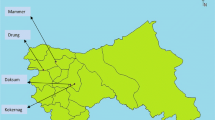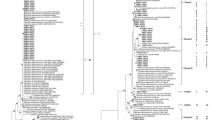Abstract
Suillus fungal specimens of pine forests from a Mediterranean area of central Spain (Madrid region) were studied based on molecular and physiological analysis of sporocarps to obtain fungal native inocula to produce mycorrhizal Pinus halepensis Miller in nursery. Variation within the internal transcribed spacer (ITS) region of the ribosomal RNA genes of Suillus was examined by restriction fragment length polymorphism (RFLP) and direct sequencing of polymerase chain reaction products. Ribosomal DNA (rDNA) spacers were amplified from pure cultures obtained from fruit bodies of a range of Suillus species: Suillus bellinii (Inzenga) Watling, Suillus bovinus (Pers.) Kuntze, Suillus collinitus (Fr.) Kuntze, Suillus granulatus (L.) Snell, Suillus mediterraneensis (Jacquet. & Blum) Redeuil, Suillus luteus L. (Gray), and Suillus variegatus (Sw.) Kuntze. Interspecific variation in the length and number of restriction sites of the amplified ITS region was observed. This variation was confirmed by sequencing, which allowed us to identify some isolates. This is the first time that the ITS sequence of S. mediterraneensis is completely described. No intraspecific rDNA variation was observed within isolates of S. collinitus, S. mediterraneensis, and S. luteus. The phylogenetic analysis established the close relationship among these Mediterranean fungal species. As a further step to characterize the different isolates and to understand the relation between genetic and functional diversity, some physiological variables were evaluated. Intraspecific variation in axenic fungal growth and in mycorrhizal capacities was detected, especially within S. collinitus isolates. The fungal isolates stimulated the growth of P. halepensis in different rates. These studies indicated that ITS analysis, in conjunction with mycorrhizal tests, provides suitable combined tools for the analysis of Suillus spp. in a small geographic area for selecting isolates with final afforestation purposes.



Similar content being viewed by others
References
Brundrett M, Bougher N, Dell B, Grove T, Malajczuk N (1996) Working with mycorrhizas in forestry and agriculture. ACIAR Monograph 32, Camberra, Australia
Cairney JWG (1999) Intraspecific physiological variation: implications for understanding functional diversity in ectomycorrhizal fungi. Mycorrhiza 9:125–135
Cazzoli P (2002) Approccio al genere Suillus. Rev Iberoam Micol 1:3–27
Dahlberg A, Finlay RD (1999) Suillus. In: Cairney JEGC, Chambers SM (eds) Ectomycorrhizal fungi, key genera in profile. Springer, Berlin Heidelberg New York, pp 33–64
Dustan WA, Dell B, Malajczuk N (1998) The diversity of ectomycorrhizal fungi associated with introduced Pinus spp. in the Southern hemisphere, with particular reference to Western Australia. Mycorrhiza 8:71–79
El Karkouri K, Martin F, Mousain D (2004) Diversity of ectomycorrhizal symbionts in a disturbed Pinus halepensis plantation in the Mediterranean region. Ann For Sci 61:705–710
Gardes M, Bruns TD (1993) ITS primers with enhanced specificity for basidiomycetes: application to the identification of mycorrhizae and rusts. Mol Ecol 2:113–118
González-Ochoa AI, De las Heras J, Torres P, Sánchez-Gómez E (2003) Mycorrhization of Pinus halepensis Mill. and Pinus pinaster seedlings in two commercial nurseries. Ann For Sci 60:43–48
Graham JH, Miller RM (2005) Mycorrhizas: gene to function. Plant Soil 274:79–100
Horton TR (2002) Molecular approaches to ectomycorrhizal diversity studies: variation in ITS at a local scale. Plant Soil 244:29–39
Jacobson KM, Miller OK (1992) Physiological variation between tree-associated populations of Suillus granulatus as determined by in vitro mycorrhizal synthesis experiments. Can J Bot 70:26–31
Kimura M (1980) A simple method for estimating evolutionary rates of nucleotide substitution through comparative studies of nucleotide sequences. J Mol Evol 4:111–120
Kretzer A, Li Y, Szaro T, Bruns TD (1996) Internal transcribed spacer sequences from 38 recognized species of Suillus sensu lato: phylogenetic and taxonomic implications. Mycologia 88:776–785
Lanfranco L, Perotto S, Longazo S, Mello A, Cometti V, Bonfante P (1998) Molecular Approaches to investigate biodiversity in mycorrhizal fungi. In: Varma A (ed) Mycorrhiza manual. Springer lab manual. Springer, Berlin Heilderberg New York, pp 353–372
Leonardi M, Paolocci F, Rubini A, Simonini G, Pacioni G (2005) Assessment of inter- and intra-specific variability in the main species of Boletus edulis complex by ITS analysis. FEMS Microbiol Lett 243:411–416
Maestre FT, Cortina J (2004) Are Pinus halepensis plantations useful as a restoration tool in semiarid Mediterranean areas? For Ecol Manag 198:303–317
Manian S, Sreenivasaprasad S, Bending GD, Mills PR (2001) Genetic diversity and interrelationships among common European Suillus species based on ribosomal DNA sequences. FEMS Microbiol Lett 204:117–121
Marx DH (1969) The influence of ectotrophic mycorrhizal fungi on the resistance of pine roots to pathogenic infections. I. Antagonism of mycorrhizal fungi to root pathogenic fungi and soil bacteria. Phytopathology 59:153–163
Mello A, Murat C, Vizzini A, Gavazza V, Bonfante P (2005) Tuber magnatum Pico, a species of limited geographical distribution: its genetic diversity inside and outside a truffle ground. Environ Microbiol 7:55–65
Moreno G, Heykoop M, Gonzalez V, Arenal F (1995) Suillus bovinoides (Blum) and Boletus roseoalbidus (Alessio & Littini) comb. nov. two interesting Mediterranean species. Doc Mycol 25:269–277
Requena N, Perez-Solis E, Azcón-Aguilar C, Jeffries P, Barea JM (2001) Management of indigenous plant-microbe symbioses aids restoration of desertified ecosystems. Appl Environ Microbiol 67:495–498
Rincón A, Álvarez IF, Pera J (2001) Inoculation of containerized Pinus pinea L. seedlings with seven ectomycorrhizal fungi. Mycorrhiza 11:265–271
Rincón A, Ruiz-Díez B, García-Fraile S, Lucas-García J, Fernández-Pascual M, Pueyo JJ, de Felipe MR (2005) Colonisation of Pinus halepensis roots by Pseudomonas fluorescens and interaction with the ectomycorrhizal fungus Suillus granulatus. FEMS Microbiol Ecol 51:303–311
Rincón A, Ruiz-Díez B, Fernández-Pascual M, Probanza A, Pozuelo JM, de Felipe MR (2006) Afforestation of degraded soils with Pinus halepensis Mill.: effects of inoculation with selected microorganisms and soil amendment on plant growth, rhizospheric microbial activity and ectomycorrhizal formation. App Soil Ecol (in press). DOI 10.1016/j.apsoil.2005.12.004
Ruiz-Díez B, Martín-Diez F, Rodríguez-Tudela JL, Alvárez M, Martínez-Suárez JV (1997) Use of random amplification of polymorphic DNA (RAPD) and PCR-fingerprinting for genotyping a Scedosporium prolificans (inflatum) outbreak in four leukemic patients. Curr Microbiol 35:186–190
Ruiz-Díez B, Martínez-Súarez JV (1999) Electrotransformation of the human pathogenic fungus Scedosporium prolificans mediated by repetitive rDNA sequences. FEMS Immunol Med Microbiol 25:275–282
Saitou N, Nei M (1987) The neighbour-joining method: a new method for reconstructing phylogenetic trees. Mol Biol Evol 4:406–425
Sambrook J, Fritsch EF, Maniatis T (eds) (1989) Molecular cloning: a laboratory manual, 2nd edn. Cold Spring Harbor Laboratory Press, Cold Spring Harbor, New York
Sen R (1990) Intraspecific variation in two species of Suillus from Scots pine (Pinus sylvestris L.) forests based on somatic incompatibility and isozyme analysis. New Phytol 114:607–616
Smith SE, Read DJ (eds) (1997) Mycorrhizal symbiosis. Academic, Cambridge
Steel RGD, Torrie JH (eds) (1980) Principles and procedures of statistics. A biometrical approach, 2nd edn. McGraw-Hill Book, Mexico
Trappe JM (1977) Selection of fungi for ectomycorrhizal inoculation in nurseries. Annu Rev Phytopathol 15:203–222
White TJ, Bruns T, Lee S, Taylor J (1990) Amplification and direct sequencing of fungal ribosomal RNA genes for phylogenetics. In: Innis MA, Gefand DH, Sninsky JJ, White TJ (eds) PCR protocols, a guide to methods and applications. Academic, San Diego, pp 315–322
Wu QX, Mueller GM, Lutzoni FM, Huang YQ, Guo SY (2000) Phylogenetic and biogeographic relationship of eastern Asian and eastern north American disjunct Suillus species (Fungi) as inferred from nuclear ribosomal DNA ITS sequences. Mol Phylogenet Evol 17:37–47
Acknowledgements
The work at the Centro de Ciencias Medioambientales was supported in part by grants 07M/0043/2001 and 07M/0089/2002 both from the Comunidad de Madrid, Spain. The authors thank F. Arenal and M. Villareal for their help with the phylogenetic analysis. BRD and AR are supported by I3P program of CSIC financed by FSE.
Author information
Authors and Affiliations
Corresponding author
Rights and permissions
About this article
Cite this article
Ruiz-Díez, B., Rincón, A.M., de Felipe, M.R. et al. Molecular characterization and evaluation of mycorrhizal capacity of Suillus isolates from Central Spain for the selection of fungal inoculants. Mycorrhiza 16, 465–474 (2006). https://doi.org/10.1007/s00572-006-0063-8
Received:
Accepted:
Published:
Issue Date:
DOI: https://doi.org/10.1007/s00572-006-0063-8




